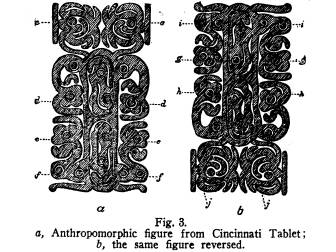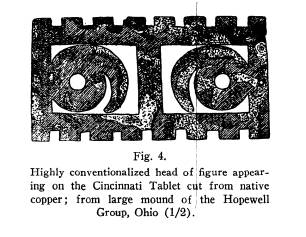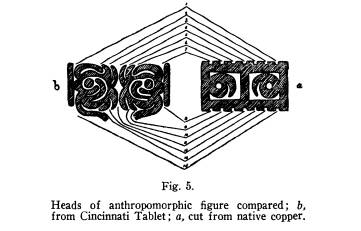Ohio History Journal
THE CINCINNATI TABLET: AN INTERPRETATION
By CHARLES C. WILLOUGHBY
The Great Horned Serpent of our American
tribes was usu-
ally considered a god of waters, lakes,
and streams. His anger
was manifested through storms, thunder,
and lightning. Forked
lightning was the darting of his
tongue. The Algonquians of
the Great Lakes believed that a monster
serpent, Gitche-Kenebig,
dwelt in these waters, who, unless
appeased with offerings, raised
a tempest, or broke the ice beneath the
feet of those trespassing
in his domain and swallowed them. When
the rivers or coastal
waters of Virginia were rough, the
priests went to the water side,
and after many outcries and invocations,
cast tobacco, copper, or
other offerings into the water to pacify
the god whom they
thought to be very angry.1
It is said that Michabo, the Algonquian
culture hero, de-
stroyed, by means of a dart, the serpent
who lived in a lake and
flooded the earth with its waters.
Michabo then clothed himself
in the skin of this foe and drove the
other serpents to the south.2
The Hidatsa made offerings to the Great
Serpent living in
the Missouri by placing poles in the
river to which robes and
blankets were attached.
The Chickasaw believed in a horned
snake, Sint-holo,3 who
lived along big creeks or in caves.
These serpents often moved
from one stream to another, and the
Indians believed that they
could cause rain in order to raise the
rivers, so as to leave their
hiding places with greater
facility. The Sint-holo is said to
have made a noise like thunder.
According to the Alabama In-
dians living in Texas, there were four
varieties of horned serpents,
distinguished by the color of their
horns. In one variety the
1 Edward Arber, ed., Works of Captain
John Smith (Edinburgh, 1910), 1, 373.
2 Daniel Garrison Brinton, Myths of
the New world, 2d ed. (New York, 1876),
122.
3 John Reed Swanton, "Social and
Religious Beliefs and Usages of the Chicka-
saw Indians," in Bureau of American Ethnology Annual Report (Washington,
D. C.,
1881--), XLIV (1926), 251.
(257)
258
OHIO ARCHAEOLOGICAL AND HISTORICAL QUARTERLY
horns were yellow, in another white, in
the third red, and in the
fourth blue.
It is well known that the horned serpent
occurs in the myths
and ceremonies of various Pueblo tribes.
He was called Skatona
by the Sia, and in ancient times was
said to have eaten the people.
By the Zuni he was known as Kolowisi.
These Indians believe
the earth to be circular and surrounded
on all sides by the ocean.
The sky (stone cover) is thought to be
solid in substance and to
rest upon the earth like an inverted
bowl. Under the earth is a
system of covered waterways, all
connected with the surrounding
ocean.
Springs and lakes, which are regarded as sacred, are
openings to this system. The underground
waters are the home
of the horned serpent, Kolowisi.4
The Cherokee tell of the serpent Uktena.
It is as large as
a tree trunk and has horns on its head
and a bright blazing crest
like a diamond on its forehead. Whoever
is seen by this serpent
is so dazed by the bright light that he
runs toward the snake in-
stead of trying to escape. Even to see
the Uktena asleep is death,
not to the hunter himself but to his
family.5
The Jesuits found a legend current among
the Huron that
there existed a monster serpent,
Onniont, who wore on his fore-
head a horn that pierced rocks, trees,
hills, in short, everything
he encountered. Whoever could obtain a
piece of this horn was
very fortunate, for it was a powerful
charm and bringer of good
luck.
The Hurons confessed that none of them had been for-
tunate enough to find this monster and
break its horn, but their
neighbors, the Algonquians, furnished
them at times with small
fragments for a large consideration.6
The Algonquians seem to have been
especially successful in
their encounters with the horned
serpent, and it was a member of
this group, a Shawnee prisoner taken by
the Cherokee, who suc-
ceeded in securing the much-coveted
ulunsuti, or "diamond" from
its head in exchange for his liberty.
James Mooney says the
4 Ruth Leah Bunzel, "Zuni Original
Myths," ibid., XLVII (1929), 487.
5 James Mooney, "Myths of the
Cherokee," ibid., XIX (1897), Part 1, 287.
6 Brinton, op. cit., 119.
THE CINCINNATI TABLET 259
Cherokee still have this powerful
talisman. It is a large trans-
parent crystal with a blood-red streak
running through its center
from top to bottom. It is kept wrapped
in a whole deer skin
inside an earthen jar, hidden in a
secret cave in the mountains.7
This "diamond," or
"blazing star," on the head of Uktena,
on account of its glittering brightness,
was sometimes called
Igaguti, Daylight, but when detached and
in the hands of a con-
jurer it became Ulunsuti, transparent.
This "diamond" is doubt-
less analogous to the sun circle in the
center of the serpent head
of copper from the great mound of the
Hopewell group, and also
analogous to the fires of the
cobblestone altar in the center of
the head of the great horned serpent
mound of Adams County.8
The above references, while by no means
exhaustive, are
sufficient to indicate the sinister
attributes ascribed to the serpent
throughout a large part of North
America.
In opposition to the baneful qualities
embodied in the serpent
are others, beneficent in character,
belonging to certain beings
who are constantly working for the
advancement and welfare of
the people. Among the Algonquians,
Michabo, the Great Hare,
was one of these. These opposing forces
of good and evil were
clearly recognized, and especially among
the more advanced
tribes, were deified, and these deities
represented by prominent
priests. The sinister gods and their
priestly representatives were
commonly connected in some manner with
the serpent, which was
usually, though not always, represented
with four horns. They
sometimes appeared as anthropomorphic
beings, part human and
part serpent.
Among the Iroquois in the latter part of
the sixteenth cen-
tury these evil forces were embodied in
the priest Wathatotarho
(Thadodaho, Atotarho). He was haughty,
ambitious, crafty, re-
morseless, and a dreaded sorcerer.
Tradition attributes to Watha-
totarho the following preterhuman
characteristics, doubtless de-
rived from the god which he personified.
His head was clothed
7 Mooney, op. cit., 298,
299.
8 Charles Clark Willoughby, "The
Serpent Mound of Adams County, Ohio," in
American Anthropologist (Lancaster, Pennsylvania, 1888--), new
Series, XXI (1919),
153-163.
260 OHIO ARCHAEOLOGICAL AND
HISTORICAL QUARTERLY
in lieu of hair with living vipers; his
hands and feet had the
shape of huge turtle-claws; his other
organs were similarly mon-
strous in form, in keeping with his
demoniacal mind. He is said
to have had "seven crooks in his
body," referring figuratively to
his unnatural hair, hands, and feet,
eyes, throat, hearing, sexual
parts, and mind.9 It will be
remembered that seven is a number
which constantly occurs in Indian
mythology. An earlier de-
scription of Wathatotarho by the same
accomplished student of
the Iroquoian people is as follows: His
hair was "composed of
writhing hissing serpents, his hands
were like unto the claws of a
turtle, his feet like unto bear's claws
in size and were awry like
those of a tortoice, and his body was
cinctured with many folds of
his membrum virile."10 These
mythical attributes seem to identify
him with the god of death and the
underworld.
A priest, apparently with similar
functions, is also found
among the Virginia Algonquians. He
presided for a period of
three days over the deliberations
of seven priests, which resulted
in the sentence of death to Captain John
Smith. As is well known,
Smith escaped execution through the
intercession of his young
friend Pocahontas. During the above
deliberations, this priest's
body was painted black and he wore a
headdress made of "a
dozen or sixteen" stuffed skins of
serpents and several weasels'
skins, their tails all tied together and
the skins hanging about his
head, back, and shoulders, and partly
covering his face.11 Is it
not possible to recognize in this priest
the attributes belonging also
to Wathatotarho of the Iroquois?
Among the Natches and the Creeks the
recognition of both
the sinister and beneficent
forces was highly developed, separate
towns being dedicated to the two
divisions, the former known as
red or war towns, and the latter as
white or peace towns. The
war chief of the Natches was called
Tattooed Serpent, the title
being hereditary.
9 John Napoleon Brinton
Hewitt, Wathatotarho, in Bureau of American Eth-
nology Bulletin (Washington, D.
C., 1887--), XXX (1910), Part 2, 921-922.
10 John Napoleon Brinton Hewitt,
"Legend of the Founding of the Iroquois
League," in American Anthropologist,
old Series, V (1892), 186.
11 Arber, op. cit., II,
398, 399.
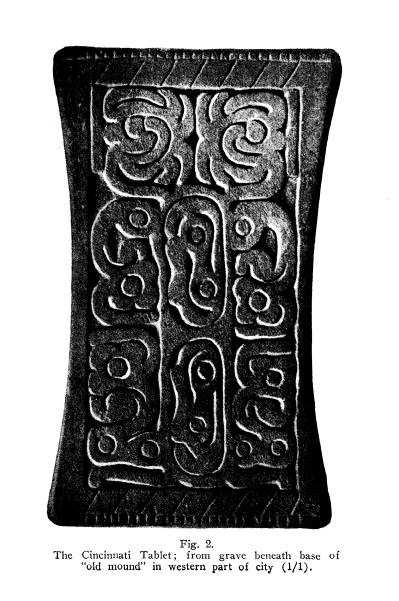
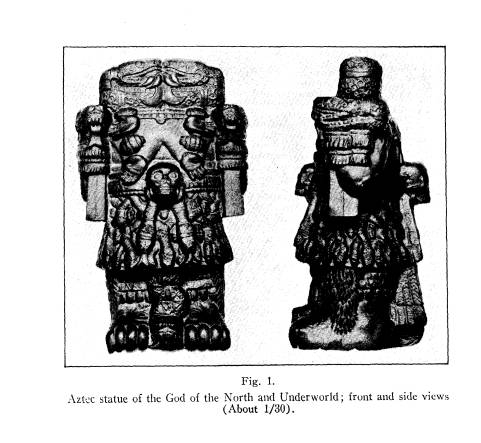
THE CINCINNATI TABLET 261
With the above facts in mind, attention is turned to the Cin-
cinnati Tablet, which was discovered in December, 1841, with
a skeleton in the "old mound" in the western part of the city.
Two well-made pointed bone implements, each about seven inches
in length, were found with it.
During the destruction of the mound, several other skeletons
in a good state of preservation and near its surface were disin-
terred. This gave rise to the inference that these burials were
made since the mound was completed. The skeleton accompany-
ing the tablet and bone implements, however, was near the center
and rather below the level of the original surface, and there was
no doubt at the time of the discovery that this was the interment
over which the mound was erected.12
The tablet, Fig. 2, is made of a piece of fine-grained, compact
sandstone of light brown color, and is about one-half inch in
thickness. Upon its back are four longitudinal grooves, three
of them quite deep, and a shorter, shallower groove near either
end, the whole having the appearance of a sharpening stone for
grinding implements of bone similar to the two dagger-like objects
which accompanied it.
The anthropomorphic being engraved upon the tablet un-
doubtedly represents the Ohio Mound-builders' conception of the
personification of those sinister forces whose recognition forms a
prominent part of the beliefs of our native people.
A comparison of this Ohio figure with another representa-
tion of this sinister god from Mexico is interesting and profitable.
This Aztec god probably represents Tezcatlipoca, Lord of the
North and Underworld, and is now in the National Museum at
Mexico, Fig. 1. The humanized head of this anthropomorphic
being is made up of two serpent heads facing each other and
joined together. The eyes of the grotesque face are composed of
one eye from each of the serpent heads. Beneath the eyes is the
broad mouth with four teeth protruding. The forked tongue
appears beneath the teeth. A gruesome necklace of human hands
12 Ephraim George Squier and Edwin Hamilton Davis, "Ancient Monuments
of the Mississippi Valley," in Smithsonian Institution Contributions to Knowledge
(Washington, D. C., 1848-1890), 1, 274, 275.
|
262 OHIO ARCHAEOLOGICAL AND HISTORICAL QUARTERLY and hearts with a human skull as a pendant, overhangs the droop- ing breasts. The monstrous arms, flexed at the elbow, terminate in serpent heads. Upon the shoulder and elbow of each arm is a set of five claws, probably of the tortoise, one claw of each set at the elbows being "awry." This does not show clearly in the illus- tration, but is distinct in the statue itself. Upon the upper side of each of the great feet, and at the elbow and shoulder joints, are eyes with eyebrows clearly defined. The pair of eyes upon each foot seems to indicate that the feet also partake of the nature of heads, the four claws representing the teeth. This being is ap- parently bisexual, the male member taking the form of a serpent. This deity was associated with the color black and with the night. It is profitable to compare the description of Wathatotarho, given above, with this sinister being. |
|
|
|
Attention is now turned to the Cincinnati Tablet as it ap- pears in Fig. 2, and in Fig. 3a. Here again is an anthropomorphic being, grotesquely human in general conception. The short, broad head has a bar-like ear upon either side, Fig. 3a, c--c. Each of the two eyes has a double curve extending downward. The broad, grinning mouth has four teeth occupying much the same position as those in the head of Fig. 1. Each arm termi- |
|
THE CINCINNATI TABLET 263 nates in a grotesque head-shaped hand, d--d, the ingenious ar- rangement of the five digits forming its outline. The feet, e--e, are like the hands reversed. These, and what seem to be the lower legs, are crooked upward at the knees, f--f. The narrow body has two oval designs, the significance of which is not clear. The hands, feet, and joints of the shoulders and legs, in addition to the various heads, are furnished with eyes, as in the Aztec sculpture. In Fig. 3b the drawing is reversed. The anthropomorphic head appears at the bottom, upside down, and in this position clearly shows the two serpent heads facing each other. Here is the typical four-horned serpent. Upon each of the heads are the four horns, two of which turn upward and two downward. The lower jaw appears in j. A further study of this curious bas-relief reveals other heads, notably at f--f, and at i--i. In the extensive deposit of native copper symbols from the Great Mound (number 25) of the Hopewell Group, Ohio, were several highly conventionalized examples of the head of this sinister god, one of which is shown one-half natural size in Fig. 4. |
|
|
|
264 OHIO ARCHAEOLOGICAL AND HISTORICAL QUARTERLY This again appears, much reduced, beside the head from the tablet in Fig. 5. |
|
|
|
It should be noted that there are seven indentations or open- ings at the top, and also at the lower portion of each. These are connected with numbered lines to make the relationship of the parts clearer. The eyes in the copper head, a, are each furnished with a single curved projection instead of with two, as in b. There are also seven diagonal lines above the head on the tablet, Fig. 2. It will be recalled that there were seven crooks in the body of Wathatotarho, and that there were seven priests, includ- ing the serpent priest who deliberated over the fate of Smith. There is undoubtedly a close connection between Watha- totarho of the Iroquois, the anthropomorphic serpent deity of the Cincinnati Tablet, and the cognate being appearing in the great Mexican statue, Fig. 1. That they are all variants of the same sinister being seems evident. There is much to be learned through a comparative study of the mythical traditions of the Indians and the various archaeo- logical remains constantly being brought to light. This phase of study has not received the attention which it deserves. |
